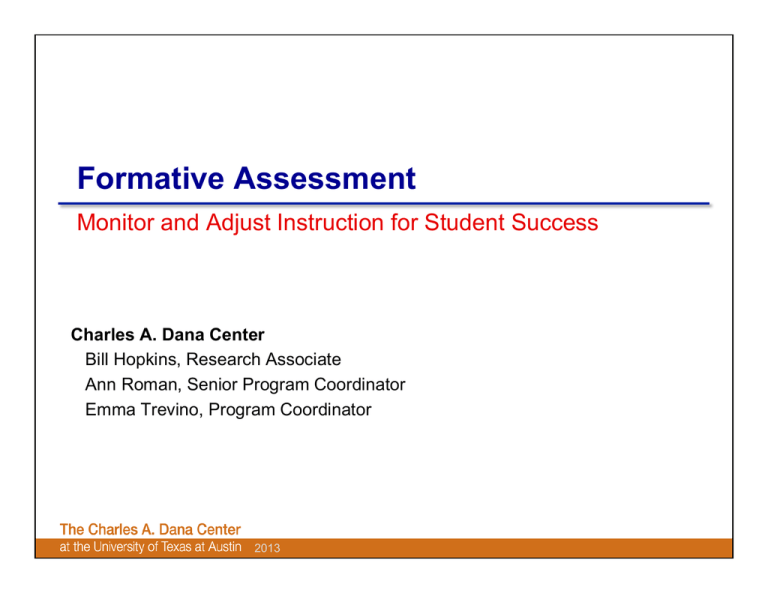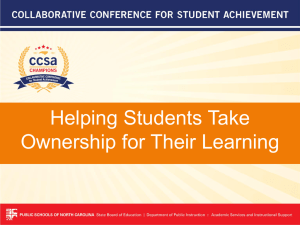Formative Assessment Monitor and Adjust Instruction for Student Success
advertisement

Formative Assessment Monitor and Adjust Instruction for Student Success Charles A. Dana Center Bill Hopkins, Research Associate Ann Roman, Senior Program Coordinator Emma Trevino, Program Coordinator 2013 Creating a vision for assessment • What does formative assessment look like in your district? • Create a graphic organizer to summarize your table discussion. 2013 2 Types of Assessment • Formative assessment • Summative assessment What’s the difference? 2013 3 The assessment continuum Where do typical assessments fall on the continuum? 2013 4 A Look at Research We use the general term assessment to refer to all those activities undertaken by teachers—and by their students in assessing themselves—that provide information to be used as feedback to modify teaching and learning activities. Such assessment becomes formative assessment when the evidence is actually used to adapt the teaching to meet student needs. Black and Wiliam (1998). Inside the Black Box. Phi Delta Kappan, 2, 139-144. 2013 5 What is Formative Assessment? Formative assessment is… “…a planned process in which assessmentelicited evidence of students’ status is used by teachers to adjust their ongoing instructional procedures or by students to adjust their learning tactics.” W. James Popham, Transformative Assessment, ASCD, 2008, page 6 Formative assessment depends on collecting data and on taking action based on the data collected. 2013 6 Applications of Formative Assessment The Formative Assessment Process Classroom Climate Immediate Instructional Adjustment Shifts Students’ Near-Future Instructional Adjustment Last-Chance Instructional Adjustment Learning Tactic Adjustments Adapted from Popham, Tranformative Assessment in Action 2013 7 Applications of Formative Assessment The Formative Assessment Process Teachers’ Instructional Adjustments Immediate Instructional Adjustment Near-Future Instructional Adjustment Last-Chance Instructional Adjustment Adapted from Popham, Tranformative Assessment in Action 2013 8 Applications of Formative Assessment The Formative Assessment Process Intended Outcomes of Effective Formative Assessment Classroom Climate Shifts Students’ Learning Tactic Adjustments Adapted from Popham, Tranformative Assessment in Action 2013 9 Applications of Formative Assessment The Formative Assessment Process Classroom Climate Immediate Instructional Adjustment Shifts Students’ Near-Future Instructional Adjustment Last-Chance Instructional Adjustment Learning Tactic Adjustments Adapted from Popham, Tranformative Assessment in Action 2013 10 The Teacher’s Role in Formative Assessment To tap the full potential of formative assessments, teachers must: • Clarify and share learning intentions and criteria for success with students. • Engineer effective classroom discussions, questions, and learning tasks. • Provide feedback that moves learners forward. • Activate students as owners of their own learning. • Encourage students to be instructional resources for one another. D. Wiliam, “Changing Classroom Practice” 2013 11 Revisit your assessment vision Based on our discussions: • What would you change about your graphic organizer? • How would you revise the assessment continuum? 2013 12 Moving into action • How are you thinking about assessment in your district based on the research? • What would you change? • What is your role in this change? 2013 13 Learning Progressions Formative assessment is a planned process, and a key component of this planning is the learning progression. “A learning progression is a sequenced set of sub-skills or bodies of enabling knowledge that, it is thought, students must master en route to mastering a more remote target curricular aim.” W. James Popham, Transformative Assessment, ASCD, 2008, page 25 Learning progressions indicate to teachers when to collect assessment evidence. 2013 14 Components of a Learning Progression There are two key components in a learning progression: • Target curricular aim – an important curricular goal that is preferably a higher level cognitive skill. It can be an objective for an extended duration teaching unit or a key learning goal for an entire course. • Building blocks – knowledge and skills that students must master before they can reach the target curricular aim (i.e., what students must know and be able to do) 2013 15 Building a Learning Progression Target Curricular Aim Building Block Building Block Building Block Knowledge Knowledge Skill Skill Skill Skill Knowledge 2013 Knowledge Knowledge 16 Learning Progressions and Assessment Design Target Curricular Aim Knowledge Skill Skill Building Block #1 Formative Assessment Knowledge Skill Knowledge Building Block #2 Formative Assessment Skill Knowledge Knowledge Building Block #3 Formative Assessment 2013 Summative Assessment 17 Formative Assessment Cycle Study Standards Make Instructional Adjustments Determine Criteria Develop Learning Progression Interpret Evidence Capture Evidence 2013 Plan the Assessment 18 Reflection What insights did you gain from this discussion that may have applications for your district? What questions do you have about our work for formative assessment? 2013 19


